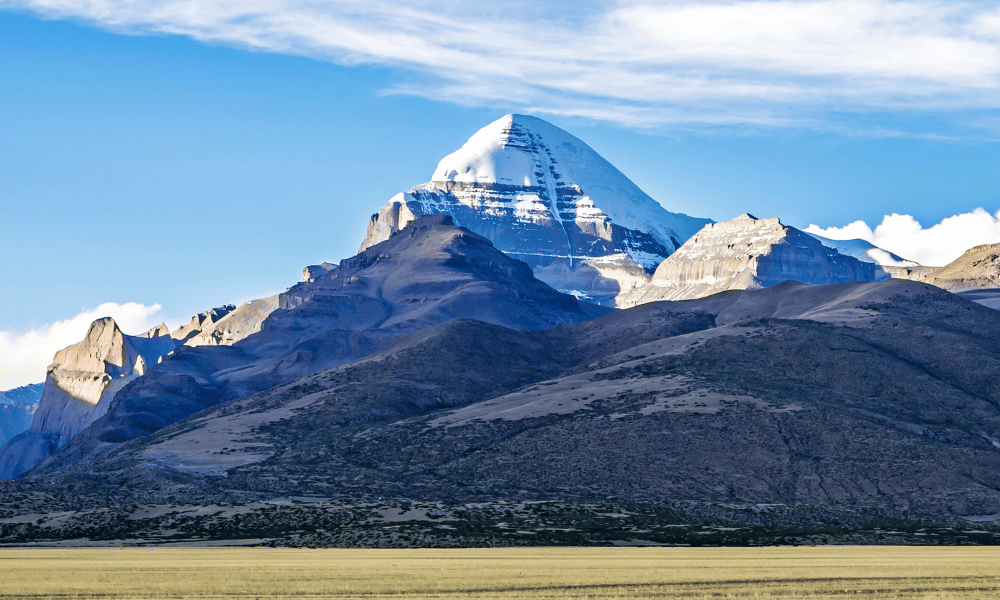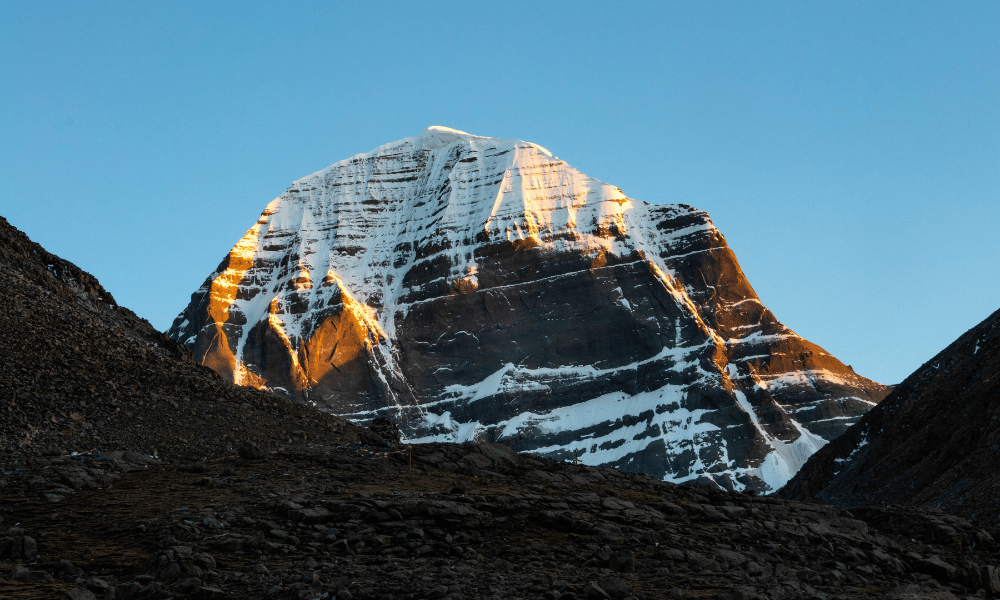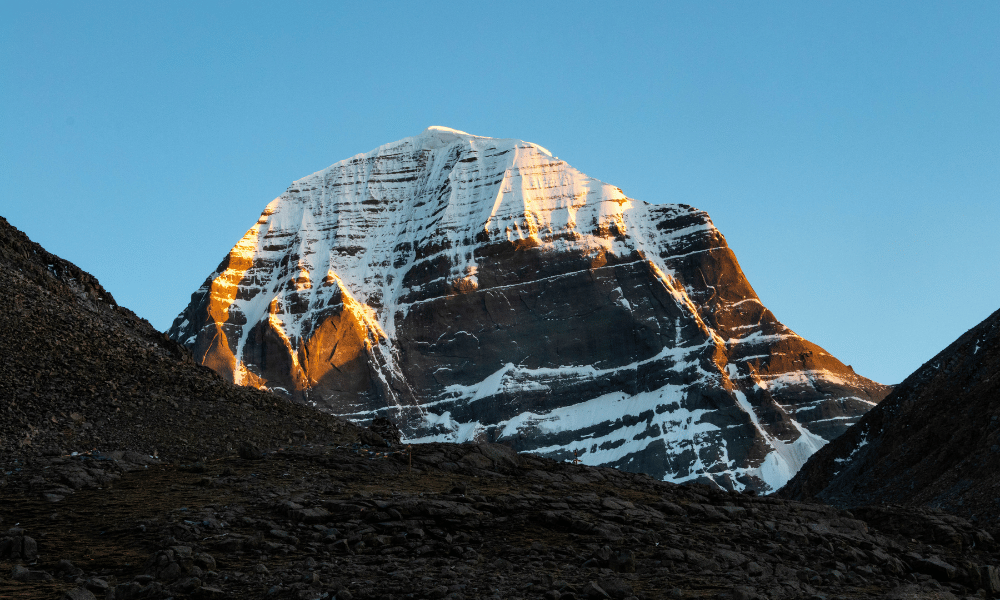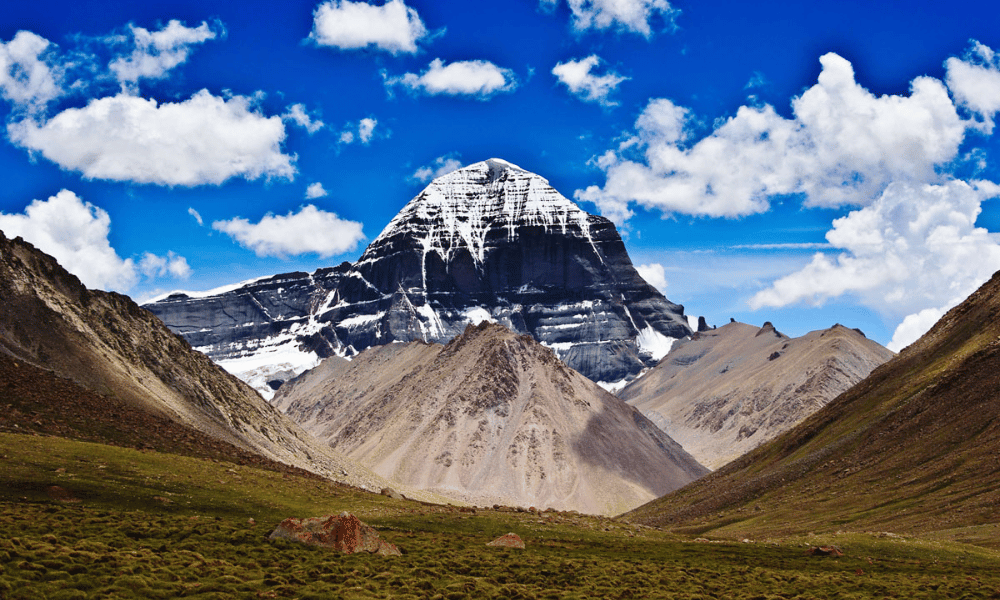Mount Kailash is a mysterious and beautiful mountain that stands in a remote part of the Tibetan plains, where the heaven seems to touch the ground. This lone giant, which sits in the Trans Himalayan range, attracts both travelers and tourists with its calming beauty and mysterious charm. Kailash is a place where spirituality and peace meet. For hundreds of years, it has been a place of great respect and wonder, mirroring the heavenly whispers of the universe and representing the unity of faiths.
Mount Kailash, in the Tibetan Autonomous Region of China, is a beautiful, remote mountain that demands respect both for its natural beauty and its religious importance. At a staggering height of 6,638 meters, it has a powerful and majestic presence. Its difficult weather and hard-to-reach location seem to protect its sacredness from the modern world.
Even so, its location is only a small part of what makes it so important. Kailash is a sacred place in the religious stories of Hinduism, Buddhism, Jainism, and the Bon belief. It is seen as a place where divine forces meet and a home for the gods. For Hindus, it is where Lord Shiva resides , and for Buddhists, it is where the god Demchok lives. In Jainism, it is seen as the place where the first Tirthankara achieved enlightenment. In the Bon religion, it is considered as a spiritual power center. This varied respect makes Mount Kailash more than just a mountain; it makes it a living thing that reflects the peace and faith that goes beyond the borders of different cultures.
As we learn more about the mystical stories and complex geology of Mount Kailash, we suggest a more refined view -that the fact that this holy mountain has never been climbed is not just due to its location. Instead, it shows a deep, shared admiration and respect for something that is seen as holy in many different cultures and religions. This relationship between the mountain and the faiths it supports shows that there is a global agreement to keep it pure. It tells us that we shouldn't see it as a summit to conquer, but as a sacred place to honor and protect. This creates a unique relationship where nature and spirituality come together in a harmonious way.
Table Of Content
Physical Characteristics
Height and Location
Mount Kailash is one of the tallest peaks in the Trans Himalayan area. It is 6,638 meters high, which is a very impressive height. It is in the Tibetan Autonomous Region of China. It is surrounded by a line of mountains that naturally separate it from Nepal. This location gives Kailash not only its impressive size, but also its remote and untouched beauty, far from the busy life of cities.
Geological Composition and Formation
Both the religious and physical stories about Mount Kailash are interesting. The mountain is mostly made of black and white granite, and its unique shape and structure show that it has been around since the Himalayan ranges formed. Its peak is very uniform and has four sides, which suggests that its shape was made by a complicated geological process, possibly involving tectonic movements and phases of glaciers. The natural rock forms and carvings made by erosion over thousands of years add to the mystery and give a glimpse of the geological wonders and evolution of time that Kailash has seen.
Climatic Conditions
The weather around Mount Kailash is just as dangerous as the mountain itself. The area has a harsh, mountain climate, with temperatures that can drop well below freezing, especially during the winter months. Summers are short, and the weather drops down just enough to give people a small window of time to go on pilgrimages and explore. Storms and heavy rain are usual in the area, and the weather can change quickly. The high altitude and thin air add to the difficult weather, making it a place where you have to respect nature and be ready for anything.
Useful Read: Best Time To Visit Kailash Mansarovar Yatra
Historical Attempts
Early Exploration and Mapping
Mount Kailash was interesting to historical explorers and tourists long before the world was mapped with modern technology. In historical texts, there are hints that kings and sages went on several trips to explore the holy mountain, adding to its legends and myths. But it wasn't until the late 1800s and early 1900s that actual mapping trips began. Explorers like Sven Hedin and Hugh Ruttledge tried to map the area, which brought Kailash to the attention of the rest of the world.
Interest from Climbers and Mountaineers
As the 20th century went on, the growing group of mountain climbers became interested in the mountain. Several well-known hikers and mountaineers started to show interest in the peak that had not yet been climbed. In the 1980s, the famous mountain climber Reinhold Messner was even given permission by the Chinese government to climb the mountain. The fact that Kailash had never been climbed became a bit of a draw, as it promised glory and fame to anyone who could reach its peak, which had stayed untouched and clean throughout history.
Why Efforts Were Abandoned: Outlining Initial Physical Barriers
But everyone who tried to climb the mountain had to stop before they could even get started. At first, there were a lot of big physical obstacles that made it hard to do anything. The climb was dangerous because of the harsh weather and difficult terrain of Kailash. Also, the altitude offered major risks, such as altitude sickness, frostbite, and other illnesses that are caused by being at a high altitude.

But more than the physical obstacles, it was the mountain's status as a holy place that made it hard to get around. As word of the planned trips spread, people all over the world, including religious groups and environmentalists, spoke out against them. Many people gave up on their goals when they realized how holy the place was and how much pressure they were under. They chose instead to respect Kailash's cultural, religious, and spiritual importance. In a way, the fact that the mountain has never been climbed became a sign of how people can respect and protect places with deep spiritual meaning, creating a unique balance between people and nature.
Religious Significance In Hinduism
Abode of Lord Shiva
In Hindu legend, Mount Kailash is the most important place as it is where Lord Shiva, one of the most significant deities in the religion, lives in heaven. Lord Shiva is often shown as a meditating saint with unstoppable power. It is believed that he lives at the top of this holy mountain, where he sits in a state of pure bliss while eternally meditating. Here, among the peaceful snow-covered hills, Lord Shiva meets with his wife Parvati, who represents the meeting of power and peace. People also believe that this place in heaven is the axis Mundi, which is where heaven and earth meet and the center of the universe is found.
Pilgrimage and Rituals
Hindus have been making journeys to Mount Kailash for hundreds of years. To get to this holy place, people have to walk a long way through rough terrain and high peaks. The Kailash Mansarovar Yatra is the most important spiritual journey. It involves going around the mountain and taking a holy dip in the Mansarovar Lake. This is thought to cleanse the mind and lead to salvation. During this journey, followers take part in a number of traditions and ceremonies to seek blessings and connect with the divine energy that the mountain gives off.
Mythological Narratives
Mount Kailash is not just a place in Hindu mythology; it also has a lot of stories that are told in many different books and writings. It is often shown as the heart of the cosmic ocean, surrounded by the pure and enlightened petals of a lotus flower. In the Puranas and the Mahabharata, the mountain is described as a bridge between the human world and the heavenly world, where people can break out of the circle of birth and death and reach moksha, or salvation. There are many stories about gods, sages, and saints who met Lord Shiva at Kailash. These stories make a vivid picture of a place where heavenly plays take place that shape the universe and the lives of people.
Religious Significance In Buddhism
A Spiritual Pillar
Mount Kailash stands out as a powerful sign of wisdom and peace in the Buddhist spiritual world. In Tibetan, it is called Kang Rinpoche, which means "Precious Snow Mountain." It is seen as a spiritual pillar where all the holy forces of the universe meet. In Buddhist cosmology, Mount Meru is the spiritual axis and heart of the world. Many Buddhists regard this mountain as a physical representation of Mount Meru. Its calm presence and strong size reflect two of the most important Buddhist teachings: that everything changes and that we must seek to grow spiritually.
Connection to Tantric Practices
Mount Kailash is an important part of Vajrayana Buddhism. It is often linked to tantric practices, a spiritual path that aims to mold everyday events into holy, enlightened insights. The mountain is thought to be the home of Chakrasamvara, who is also known as Demchok and is a god who represents happiness. With its valleys, rivers, and lakes, the area's holy landscape forms a natural mandala, a spiritual symbol that represents the universe. This makes it a good place for deep meditation and tantric practices that aim to bring practitioners closer to enlightenment.
Stories and Legends
Buddhism tells many stories and tales about Mount Kailash that show it as a place with a lot of spiritual importance. One of these stories is about Milarepa, a Buddhist saint who lived in the 11th century and competed with Naro Bon-chung, a follower of the Bon faith, to find out which was the true religion of Tibet. Milarepa won a number of mystical contests, which made Buddhism the most important religion in the area. Also, it is thought that in a past life, the Buddha gave his body to a starving tigress at Kailash. By doing this, he lived up to the Bodhisattva ideal of kindness and self-sacrifice.
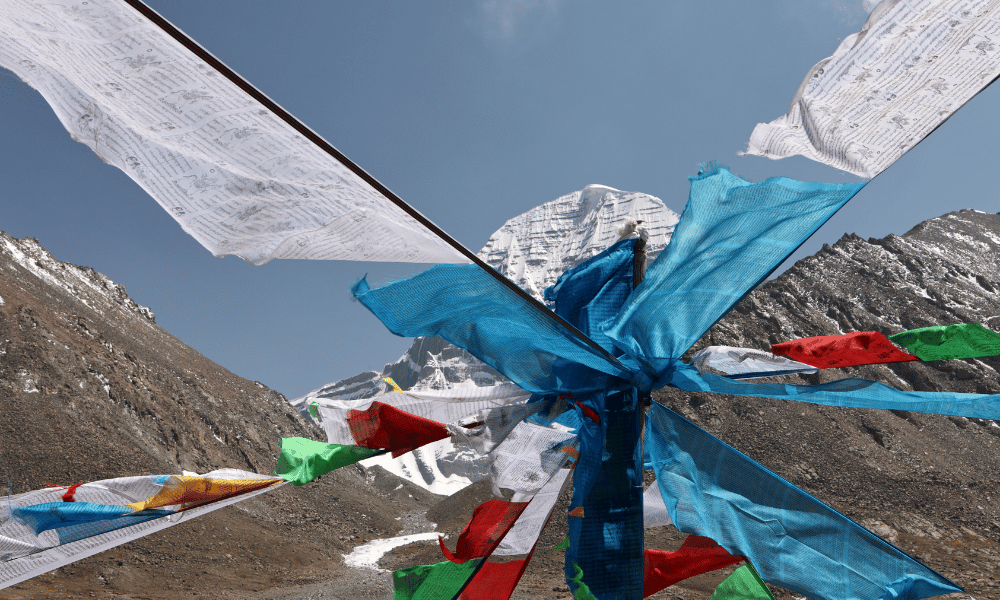
Through these stories, Mount Kailash becomes a live example of Buddhist teachings and philosophies. This creates a deep spiritual connection that brings monks, nuns, and lay Buddhists from all over the world to seek enlightenment and inner peace in its holy area.
Useful reads: Buddhist Monasteries in Nepal
Jainism and Bon Religion
Importance in Jainism: Astapada, the Mountain Next to Kailash
Mount Kailash holds significance in Jainism, a religion that is based on the spirituality and philosophy of nonviolence and truth. This is mainly because it is close to Astapada, a sacred mountain that is thought to be where the first Jain Tirthankara, Rishabhadeva, attained moksha, or freedom. With its peaceful landscapes and raw beauty, the region is a good place for spiritual reflection and pilgrimages. It embodies the Jain ideals of discipline and meditation, which are essential to the religion. Pilgrims go to these holy mountains to pay their respects, think about what the Tirthankaras taught, and try to free themselves spiritually.
Significance in Bon: Center of the World
Mount Kailash, also called Yungdrung Gutsek, is a very important part of the ancient Bon religion, which was the primary faith in Tibet before Buddhism came along. It is thought to be the center of the world and a powerful source of spiritual energy, where the heavens and the earth meet. Bon followers think of Kailash as the center of spiritual power and the place where the religion's founder, Tonpa Shenrab, came down from heaven to share his teachings. The mountain's magical features and mysterious atmosphere make it easy to feel close to the spiritual world. It is a place where people can do rituals, meditate, and hold events to seek blessings and spiritual enlightenment.
Interrelation of Religious Beliefs and Respect for the Mountain
The way that different religious views about Mount Kailash connect to each other shows how important it is spiritually for everyone. Even though people have different stories and traditions about the mountain, they all value and honor it, which makes it possible for different cultures and beliefs to live together in peace. It becomes a unifying force, a sacred place where people from different backgrounds come together, all of them respecting and admiring the mountain's holiness. This respect goes beyond individual beliefs and leads to a group decision to keep the mountain's purity by not climbing it. This shows respect for the mountain's holy status and keeps its spiritual essence safe for future generations.
Governmental Protections
Laws and Regulations on Climbing
To protect the sacred lands and fragile environment of Mount Kailash, the government has put in place a number of laws and rules that limit hiking and other activities that may harm the site. These rules show how much the government cares about protecting this sacred mountain, both for its natural beauty and for the deep cultural meaning it holds. According to these rules, no one is allowed to try to climb the mountain. This makes sure that Kailash stays pure and safe for future generations. These rules are part of a larger effort to protect and preserve natural and culturally important sites around the world.
Establishment of Nature Reserves
Along with strict rules about climbing, the government has taken steps to set up nature reserves around Mount Kailash. The purpose of these reserves is to protect the unique plants and animals of the area. This helps to promote biodiversity and ecological balance. The creation of these nature reserves is also meant to promote sustainable tourism. Visitors will be able to enjoy the mysterious beauty of Kailash without harming the area's natural beauty. With these programs, the government wants to help people live in harmony with nature so that the spiritual energy of Kailash can be felt in its pure, unspoiled form.
International Recognition and Cooperation
Mount Kailash is important to people all over the world, so many foreign groups cooperated with the government to protect it. This includes working with foreign groups who seek to protect the environment and putting Kailash in programs that protect World Heritage Sites. These attempts are made possible by the fact that Kailash is recognized around the world as a place with great religious and cultural importance, which brings support from communities and governments all over the world. This global cooperation shows that everyone wants to keep the mountain's sacred status. It also helps build international relationships based on mutual respect for cultural heritage and the environment.
Conservation Efforts
Protecting the Fragile Ecosystem
The area around Mount Kailash is known for its fragile ecosystem, which is a careful balance of plants and animals that survive the harsh weather. In this area, conservation efforts are focused on taking steps to protect local species, stop soil erosion, and keep water sources clean. Scientists and researchers are encouraged to do more studies and research to learn more about how the ecosystem works and come up with ways to stop the environment from getting worse. Also, both tourists and locals are encouraged to do things in a sustainable way so that the delicate ecology of the area doesn't get messed up and people can live in harmony with nature.
Safeguarding Sacred Sites
Mount Kailash is home to several holy and culturally important places. In this way, conservation efforts focus on keeping these places sacred, preventing vandalism, and protecting them from the negative consequences of increased tourism. Methods of preservation are used to protect old books, paintings, and other artifacts that show the region's rich cultural history. Conservation efforts aim to teach people to have great respect for the cultural and spiritual values that Kailash represents and to pass this respect on to future generations.
Community Engagement and Awareness Programs
Community involvement is one of the most important parts of conservation attempts in the area. Local people are actively engaged in conservation efforts. They use their traditional knowledge and respect for the mountain to encourage practices that are good for the environment. Locals and tourists are taught about the importance of Mount Kailash through awareness programs. This encourages responsible tourism and builds an attitude of respect for the mountain's sacred status. These programs also want to make a place where people from different groups can work together to talk about and put into action ways to protect Kailash, using both modern conservation methods and ancient wisdom and spirituality.
The Ethics of Climbing Sacred Mountains
Respect for Cultural and Religious Beliefs
Climbing mountains is often seen as a test of a person's strength and will, but when it comes to holy mountains like Mount Kailash, it takes on a different meaning. Climbing can be seen as a violation of the deep respect and beliefs that many cultures have for this peak. It encourages a moral stance in which respect for cultural and religious values is more important than personal success. Understanding and respecting the feelings of the people who see these mountains as the homes of gods or spiritual places is a basic moral duty that promotes peace and understanding in a multicultural society.
Environmental Concerns and Impacts of Climbing
Mountaineering has become increasingly popular in many parts of the world, which has brought to light the negative impacts it can have on the environment. Sacred mountains are naturally fragile places that could get worse because of what people do. Climbing may contribute to soil erosion, scare away local wildlife, and pollute these untainted places. So, ethical considerations include using methods that minimize damage to the environment and give protection and conservation of these natural wonders greater importance than exploration and sport.
Lessons from Other Sacred Mountains
Learning from what has happened on other holy mountains around the world can help make ethical rules and policies more effective. Many holy mountains have had problems like overcrowding, commercialization, and environmental damage. By examining these case studies, the government can come up with plans that help spiritual tourism but also protect the sacred value and natural balance of these places. Mountains like Mount Sinai in Egypt and Mount Fuji in Japan can be used as stories of caution to teach people how to explore holy mountains in a responsible and respectful way.
Modern Perspectives
The Shift in Mountaineering Goals
In recent years, the goals and aims of mountaineering expeditions have changed in a clear way. Focus has been shifting away from climbing mountains as a way to show how strong and determined people are and toward being more in tune with nature. Modern mountaineers often stress the importance of climbing in a responsible way, which means respecting holy places like Mount Kailash. This change is part of a larger shift in society's values, where knowing and respecting different cultures and their beliefs are seen as important parts of being a good global citizen.
Growing Awareness and Respect for Indigenous Perspectives
In the modern age, people are becoming more aware of how important it is to keep indigenous perspectives and knowledge alive. This includes how they treat sacred mountains like Kailash, which are strongly rooted in the culture, religion, and philosophy of the local people. Governments, groups, and people are becoming more aware of the need to include these points of view in policies and practices. They want to encourage a deeper connection with nature and a more complete approach to conservation and tourism. Based on this understanding, there are educational programs, community events, and media stories that try to show the rich cultural tapestry that surrounds Mount Kailash and assist visitors to respect and understand the indigenous stories.
Mount Kailash as a Symbol of Global Harmony
Mount Kailash is a symbol of peace and unity in a world that is often full of dispute and division. It is highly respected by many different religions and countries, which makes it a powerful symbol of unity and peace. The group's choice not to climb the mountain was based on mutual respect and understanding, and it sets a great example for international cooperation. It shows how different groups can work together to protect and keep something bigger than themselves. In this setting, Mount Kailash becomes a living example of the possibility of world peace. It encourages people all over the world to follow the principles of kindness, compassion, and collaboration in their interactions with nature and other people.
Useful read: Kailash Mansarovar Yatra In 2024 | Kailash Mansarovar Yatra From UK | Kailash Mansarovar Yatra From USA
Conclusion
As we explored the different aspects of Mount Kailash, we found a number of different reasons why it has never been climbed. Kailash has never been conquered by humans because it has dangerous physical features that keep even the most experienced mountaineers away, and past efforts have always been stopped out of respect for its holiness. More importantly, its deep roots in Hinduism, Buddhism, Jainism, and the Bon faith make it an immovable barrier that keeps people from messing with its purity and holiness. With strict government protections and concerted conservation efforts, the mountain is a live example of how much people respect nature and Gods.
Closing Remarks
Mount Kailash is more than just a physical wonder because of how grand and mysterious it is. It has turned into a symbol of cultural harmony and conservation of the environment in the modern world. It is valued and respected by a number of religions and cultures, and its untouched slopes reflect that. Kailash is a beacon of hope in a time when protecting the environment has become more important than ever. It symbolizes the ideals of sustainability, respect for indigenous beliefs, and global harmony.
As the world gets more complicated, Kailash's role in bringing people from different cultures and communities together and teaching them to value each other becomes even more important. It calls on people to work together to protect not only its physical structure but also what it stands for, which is the peaceful coexistence of different faiths and the care of a delicate ecosystem. The decision to keep its slopes from being climbed is not just a sign of respect for how important it is, but also a way to support cultural harmony and protect the environment.
As we stand at a turning point in history, let Mount Kailash be a gentle reflection of the beauty of respect, the power of unity, and the huge difference it makes to choose conservation over conquest. Let it encourage future generations to walk the path of respect, understanding, and working together, creating a world that celebrates diversity and values the sacred nature of all its natural wonders.
Frequently Asked Questions (FAQs)
What Makes Mount Kailash Considered Unclimbable?
Mount Kailash is considered unclimbable primarily due to its sacred status in several religions including Hinduism, Buddhism, Jainism, and the Bon religion. Additionally, the harsh climatic conditions and the mountain's remote location add to its inaccessibility.
Has Anyone Ever Attempted to Climb Mount Kailash?
Yes, there have been a few instances where climbers and explorers have shown interest in scaling the mountain. However, most have abandoned their plans out of respect for the religious sentiments associated with Kailash or due to the government restrictions in place.
Why is Mount Kailash Important in Various Religions?
Mount Kailash holds a central place in several religious narratives. In Hinduism, it is considered the abode of Lord Shiva. Buddhists regard it as a representation of Mount Meru, the center of the universe. It is also a significant pilgrimage site in Jainism and the Bon religion, which further accentuate its religious importance.
What are the Governmental Regulations Regarding Climbing Mount Kailash?
The Chinese government, which oversees the region where Mount Kailash is located, has prohibited climbing the mountain to protect its sacred status and preserve the fragile ecosystem of the region. This is coupled with international cooperation to maintain the sanctity of the site.
How Does the Decision to Keep Mount Kailash Unclimbed Reflect Modern Perspectives?
The decision to keep Mount Kailash unclimbed aligns with the modern shift towards respecting indigenous beliefs and fostering global harmony. It serves as a symbol of unity, showcasing a collective effort to prioritize cultural respect and environmental conservation over exploration and adventure.
What Lessons can be Learned from the Conservation Efforts at Mount Kailash?
The conservation efforts at Mount Kailash showcase a multifaceted approach to protecting a revered site, blending environmental conservation with the safeguarding of cultural heritage. It offers a blueprint for how communities can come together to protect and preserve significant landmarks, fostering a harmonious relationship between humans and nature.


